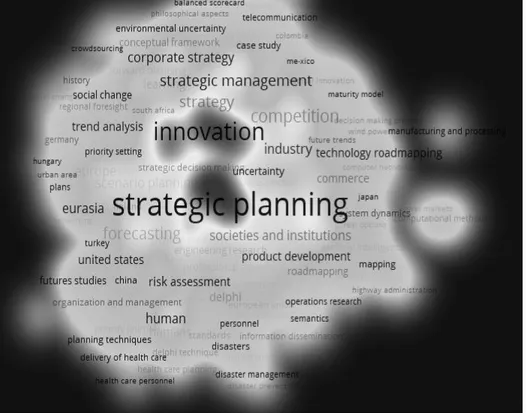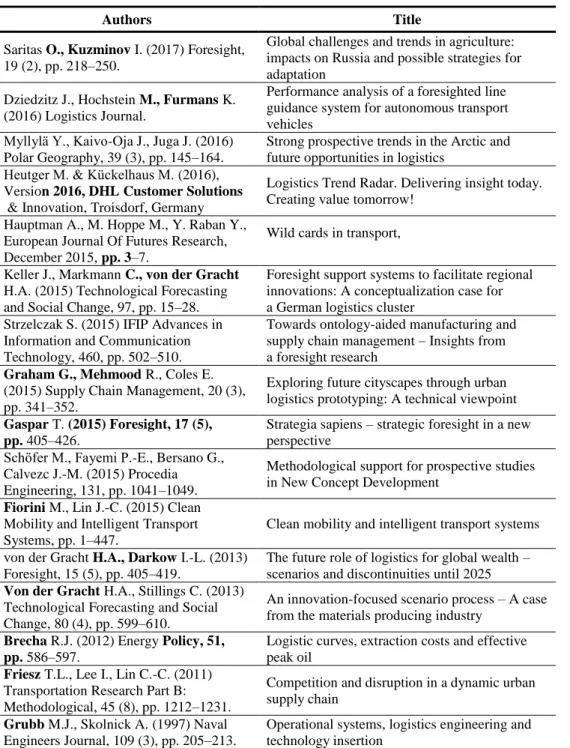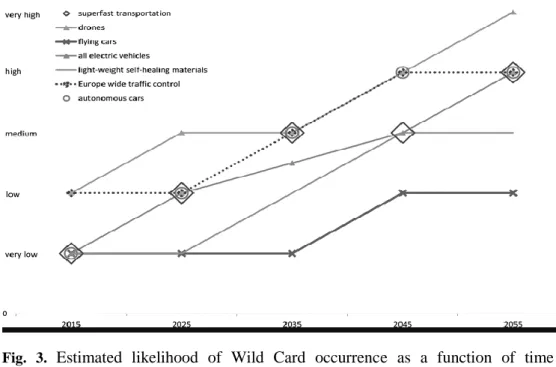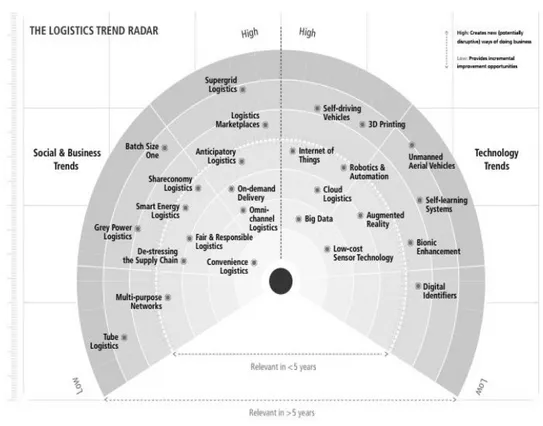STRATEGIC FORESIGHT IN LOGISTICS
– POSSIBILTIES OF APPLICATION
Anna Kononiuk
Management Faculty, Bialystok University of Technology, Bialystok, Poland, E-mail: a.kononiuk@pb.edu.pl
Abstract: The aim of the article is to present the application possibilities of strategic foresight research for the logistics field. The first part of the paper is devoted to the presentation of the bibliometric analysis which aim was to locate logistics within the foresight research. The bibliometric analysis was supported by VOS software, which is a mapping technique that stands for visualization of similarities. The second part of the paper is devoted to the presentation of two possible applications of strategic foresight for logistics, namely EU FP7 project RACE2050 and the Logistics Trend Radar. The empirical contribution of the paper is the presentation of logistics localization in the strategic foresight field. In the paper the following research methods have been used: bibliometric analysis, literature review, critical analysis of the existing published works and a case study
Paper type: Research Paper Published online: 31 January 2018 Vol. 8, No. 1, pp. 77–89
DOI: 10.21008/j.2083-4950.2018.8.1.6 ISSN 2083-4942 (Print)
ISSN 2083-4950 (Online)
© 2018 Poznan University of Technology. All rights reserved.
Keywords: strategic foresight, bibliometric analysis, logistics, VOS software, the Logistics Trend Radar
1. INTRODUCTION
Logistics seem to constitute an attractive research area for a wide array of forward looking activities. As noted by Ejdys et al. 2016 “The future of moving people and goods from one place to another may be seen as a variable that is heavily dependent on a wide array of heterogeneous factors” (Ejdys et al., p. 377). This provides a space for an interdisciplinary future-oriented reflection where various economic, social, technological, environmental, political and value-related factors come into prominence. The aim of this paper is to present the possibilities of strategic foresight implementation for logistics field.
The notion of strategic foresight is very capacious. On the basis of the literature review a working definition of strategic foresight for the purpose of the article could be as follows: strategic foresight is a leader driven participatory and systematic process that looks at the future as a mid-long term vision identifying risks and opportunities in the sociocultural, economic, environmental, political, legal and technological (STEEPVL) area, accepting the possibilities of wild cards occurrence with the aim to support decision-making, to trigger the innovation process and to build scenarios to be communicated (Becker 2002, Burmeister et al., 2004, Daheim & Uerz 2008, Cuhls 2003, Rohrbeck et al., 2007, Kononiuk 2016). As posited by Sacio-Szymańska et. al. (2016) in order to cope with the rapid, interconnected and discontinuous change, companies should develop new capabilities and new practices, which are based on a proactive attitude, oriented towards: readiness, flexibility and sensitivity (Sacio-Szymańska, 2016, p. 13). This assumption seems to be also true for the logistics companies that act in the constantly changing environment. These companies need to combine three features stemming from the accelerated change and genuine uncertainties in the business environment, namely resiliency, promptness and ambidexterity. Resiliency may be understood as the ability to go back to normality after exceptional imbalance. Promptness may be defined as the ability to immediately cope with new challenges; to collect, analyse and select necessary information, and to take fast decisions to boost and/or re-orient the business, whereas ambidexterity stands for permanently introducing product and process innovations both at incremental and at disruptive pace (Sacio-Szymańska, 2016, p. 13). In the next part of the article, the possible convergence between foresight and logistics is presented. The qualitative analysis of the articles was proceeded by bibliometric analysis.
2. BIBLIOMETRIC ANALYSIS
The literature review on foresight in logistics was preceded by a bibliometric analysis based on the SCOPUS database, which enabled the author to locate logistics in the strategic foresight field. The selection of the following database was
determined by its availability. The author collected articles from the period 1976–2017. For the purpose of the research, the author created a database containing 804 items including 570 scientific articles, 123 conference papers, 70 reviews, 27 book chapters, and 14 articles in press containing the phrase “strategic foresight.” The majority of the articles came from the following foresight journals, such as Technological Forecasting and Social Change (94 articles), Foresight (84 articles), Futures (51 articles), Journal of Futures Studies(17 Articles), Futuribles Analyse Et Prospective (14 articles), Technology analysis and strategic management (16 articles). For the purpose of the bibliometric analysis, the author of the article applied VOS, which is a mapping technique that stands for visualization of similarities and has been used for constructing bibliometric maps in a number of studies (van Eck, Waltman, 2016).
Fig. 1. The network visualization of the terms co-occurrence with the term strategy foresight based on existing published works from the 1987–2017 period; own work
The author carried out co-occurrence analysis in relation to key words appearing in the published works on strategic foresight from the researched period of time . In the co-occurrence analysis, the relatedness of items is determined on the basis of the number of documents in which they occur together. The above mentioned set of data was then subject to preliminary analysis – the exclusion of words carried out by the author of the article on the basis of her expertise in the field of foresight research. Words such as article, review and other extraneous terms were excluded. In the first phase of the preliminary analysis, of 3729 key words, 437 met the threshold of 3, which was the minimum number of occurrences of a key word. In the second phase, 431 terms were left (only 6 words were excluded by the author of the article). The network visualization and density visualization are presented in Fig. 1 and in Fig. 2.
Fig. 2. A co-word analysis of the term strategic foresight density visualization carried out based on the existing published works from the 1976–2017 period, own work.
When the network visualization is selected, items are indicated by their label and, by default, also by a circle. For each item presented in Fig. 1, the size of the item’s label and the size of the item’s circle depend on the weight of the item,
whereas the color of an item is determined by the cluster to which the item belongs. The distance between the keywords in the visualization approximately indicates the relatedness of the keyword in the key words co-occurrence network. In general, the closer two key words are located to each other, the stronger their relatedness in terms of co-occurrences links. Lines indicate the strongest co-occurrence links between key words (van Eck, Waltman, 2016). On the basis on the network presented in Figure 1, one may indicate that the words that most frequently co-occur with the term “strategic foresight “are strategic planning, foresight, innovation and strategy which presents the role strategic foresight may play in the organizations, i.e. as a tool of strategic planning, promoting foresight attitude in the company, enhancing and stimulating innovation processes and a base for a company’s strategy development. This tendency may be also observed in the density visualization (Fig. 2).
The larger the number of items in the neighbourhood of a point and the higher the weights of the neighbouring items, the closer the color of the point is to red. Conversely, the smaller the number of items in the neighbourhood of a point and the lower the weights of the neighbouring items, the closer the color of the point is to blue (van Eck, Waltman 2010, p.6). The key words characterizing logistic field seem to be marginal in the strategic foresight field. Although on the basis of words co-occurrence analysis, the author identified some key words from the logistic sphere that co-occur with the term strategic foresight, namely: automotive industry (number of occurrences 8), supply chain (number of occurrences 6), transportation (number of occurrences 6), supply chain management (number of occurrences 6), transport system (number of occurrences 3) and urban planning (number of occurrences 11). In the next step of the research process, the author of the article focused on the 16 existing published works published within SCOPUS database for the further qualitative analysis which aim was to identify best practices of the strategic foresight application in the logistics field. The authors of the articles and the thematic scope of the articles are presented in Tab. 1.
Table 1. Existing published works on strategic foresight in logistics published within SCOPUS database, own work
Authors Title
Saritas O., Kuzminov I. (2017) Foresight, 19 (2), pp. 218–250.
Global challenges and trends in agriculture: impacts on Russia and possible strategies for adaptation
Dziedzitz J., Hochstein M., Furmans K. (2016) Logistics Journal.
Performance analysis of a foresighted line guidance system for autonomous transport vehicles
Myllylä Y., Kaivo-Oja J., Juga J. (2016) Polar Geography, 39 (3), pp. 145–164.
Strong prospective trends in the Arctic and future opportunities in logistics
Heutger M. & Kückelhaus M. (2016), Version 2016, DHL Customer Solutions & Innovation, Troisdorf, Germany
Logistics Trend Radar. Delivering insight today. Creating value tomorrow!
Hauptman A., M. Hoppe M., Y. Raban Y., European Journal Of Futures Research, December 2015, pp. 3–7.
Wild cards in transport, Keller J., Markmann C., von der Gracht
H.A. (2015) Technological Forecasting and Social Change, 97, pp. 15–28.
Foresight support systems to facilitate regional innovations: A conceptualization case for a German logistics cluster
Strzelczak S. (2015) IFIP Advances in Information and Communication Technology, 460, pp. 502–510.
Towards ontology-aided manufacturing and supply chain management – Insights from a foresight research
Graham G., Mehmood R., Coles E. (2015) Supply Chain Management, 20 (3), pp. 341–352.
Exploring future cityscapes through urban logistics prototyping: A technical viewpoint Gaspar T. (2015) Foresight, 17 (5),
pp. 405–426.
Strategia sapiens – strategic foresight in a new perspective
Schöfer M., Fayemi P.-E., Bersano G., Calvezc J.-M. (2015) Procedia Engineering, 131, pp. 1041–1049.
Methodological support for prospective studies in New Concept Development
Fiorini M., Lin J.-C. (2015) Clean Mobility and Intelligent Transport Systems, pp. 1–447.
Clean mobility and intelligent transport systems von der Gracht H.A., Darkow I.-L. (2013)
Foresight, 15 (5), pp. 405–419.
The future role of logistics for global wealth – scenarios and discontinuities until 2025 Von der Gracht H.A., Stillings C. (2013)
Technological Forecasting and Social Change, 80 (4), pp. 599–610.
An innovation-focused scenario process – A case from the materials producing industry
Brecha R.J. (2012) Energy Policy, 51, pp. 586–597.
Logistic curves, extraction costs and effective peak oil
Friesz T.L., Lee I., Lin C.-C. (2011) Transportation Research Part B: Methodological, 45 (8), pp. 1212–1231.
Competition and disruption in a dynamic urban supply chain
Grubb M.J., Skolnick A. (1997) Naval Engineers Journal, 109 (3), pp. 205–213.
Operational systems, logistics engineering and technology insertion
On the basis of the literature review of the articles mentioned above, one may notice that the thematic scope of the articles is quite diverse. Although one may identify a group of the articles dealing with the issues of trends (Saritaz & Kuzminov, 2017; Myllylä, Kaivo-Oja & Juga 2016; Heutger & Kückelhaus 2016; von der Gracht & Darkow, 2013) or the application of strategic foresight for the transport development (Dziedzitz, Hochstein & Furmans, 2016; Fiorini & Lin, 2015; Hauptman, Hoppe & Raban, 2015).
3. BEST PRACTICES OF FORESIGHT IN LOGISTICS
Out of the 16 existing published works dealing with the issue of logistics, the author of the article would like to present best practices and potential benefits of using foresight studies in the process of creating the future of the broadly understood logistics. The criteria adopted by the author of the article for the definition of the best practices are the following:
• universality of the practice – easy access to documentation on the scope of the practice, especially clarity and accessibility of the description of the adopted methodological procedure;
• repeatability – a possibility of applying a given practice or its modification again in another logistics field regardless of the specificity of sector
• the practice has assumed a character of methodical procedure;
• the practice constitutes a novel solution compared to other popularly used solutions.
The first interesting example of the strategic foresight application for logistics may be found within EU FP7 project RACE2050. The aim of the project was to construct alternative futures of the European transport industries. In parallel to the construction of “conventional” scenarios, the authors of the project considered several potentially surprising and disruptive future developments. Thus, an app-roach mixing different methods and perspectives was developed combining several steps: 1. Identification of Wild Cards based on literature and experts, 2. Asses-sment of Wild Cards impact and likelihood by an online expert survey and identification of related Weak Signals, 3. Linking Wild Cards with a classical SWOT analysis to: i) exploring additional impact factors for competitiveness and blind spots, ii) providing insights on dynamics of future development due to conflicting impacts of wild cards and iii) identifying potential synergies between Wild Cards and ongoing trends. For each Wild Card, experts assessed likelihood in different time-frames, the impact on and vulnerability of different industry segments, the breadth of the effect, and the importance for decision makers to prepare. According to experts’ opinions, the likelihood of most technological transport-related Wild Cards is expected to increase over time – especially drones,
Europe-wide traffic control, autonomous cars, and superfast transport, as well as all electric cars (Hauptman, Hoppe & Raban 2015) (Fig. 3).
Fig. 3. Estimated likelihood of Wild Card occurrence as a function of time (Hauptman, Hoppe & Raban, 2015, pp. 3–7)
Faster versions of already established technologies are expected to appear – while likelihood for more visionary technologies, such as flying cars but also material innovation, seems to be less important (Hauptman, Hoppe & Raban, 2015). The author of the article sees a great potential of the methodology designed for further use and investigation, especially the concepts of wild cards and its further evaluation by the experts seem to be appealing for the use in the other logistics projects.
Another interesting application of the strategic foresight research in logistics is DHL Trend Research, a program promoting a customer-centric and open approach to identifying trends (Heutger & Kückelhaus, 2016, p.1). As noted by Heutger and Kückelhaus The Logistics Trend Radar is a key instrument for the global logistics community. It enables to capture the development of society, business and technology trends and in this way became a benchmark for strategy and innovation in the logistics industry (Heutger & Kückelhaus, 2016, p.1). The first source of the information for the radar is megatrends which are often global, stable, long-term changes that determine broader context, the second source are microtrends and start-ups, the third source is a broad network of industry experts, whereas the fourth source of the information are customers (p. 6). The Logistics Trend Radar is presented in Fig. 4.
Fig. 4. The Logistics Trend Radar (Heutger & Kückelhaus, 2016)
The authors of the report evaluated the impact of the trends for the field of logistics. In Tab.2, there are presented the social, business and technology trends that would have a very high impact for the logistics in the time frame < 5 years.
The trends that are characterized by the very high impact for logistics are: big data, cloud, logistics, Internet of Things, Robotics and Automation, anticipatory logistics, omni-channel logistics and on-demand-delivery. According to the authors of the report trends of the medium impact for logistics are batch size one, convenience logistics, de-stressing the supply chain, fair and responsible logistics, grey power logistics, share economy logistics, smart energy logistics, augmented reality, bionic enhancement, low-cost sensor technology, self-learning systems and unnamed aerial vehicles.
Table 2. Trends with a very high impact for logistics; own work based on (Heutger & Kuckelhaus, 2016)
Name and
type Impact Timeframe Summary
big data, T high < 5 years
Logistics is being transformed through the power of data-driven insights. Unprecedented amounts of data can now be captured from various sources along with supply chain.
Cloud
logistics, T high < 5 years
Ideal for complex, volatile environments, cloud computing enables new ‘logistics-as-a-service’ (LaaS) – based business models. Logistics providers can activate and deactivate
customizable, modular cloudservices on demand using a pay-per-use approach.
Internet of
Things, T high < 5 years
The Internet of Things empowers smart objects to be active participants in self-steering, event-driven logistics processes. Logistics is one of the major industries that will benefit from the intelligent conjunction of information and material flows
Robotics and Automation, T
high < 5 years
Robotics and automation technologies support zero-defect logistics processes and enable new levels of productivity. The new generation of collaborative robots and automated solutions with significantly improved performance and enhanced sensing capabilities offers a genuine alternative to manual handling.
Anticipatory Logistics, B, S
high < 5 years
Powered by big data-based predictive algorithms, anticipatory logistics enables logistics providers to significantly boost process efficiency and service quality by predicting demand before it occurs, to achieve faster delivery times and enhanced capacity and network utilization.
Omni-channel logistics, B, S
high < 5 years
The next generation of retail requires logistics networks tailored to the needs of each single channel. This will require logistics providers to maintain an integrated view of all customer channels and inventory, along with dynamic delivery and fulfillment options and seamless customer service interactions.
On-demand
delivery high < 5 years
Delivery is no longer owned by larger players who set limitations on delivery times and locations. New on-demand last-mile delivery concepts utilize the power of the crowd and flexible courier workforces to enable customers to have their purchase delivered when they need it, where they need it.
The trends which have low impact are multi-purpose-networks, tube logistics and digital identifiers. The description of the trends mentioned above may be found in the quoted report. The authors describe each of the trends in a very detailed way, presenting key opportunities, key challenges and trend assessment for each of the item on the radar (Heutger & Kückelhaus, 2016, pp.16–17). According to the author of the article, the Logistics Trend Radar could enhance strategic decisions processes taken by logistics companies. The managers could confront the visions of the companies development with the trends presented on the radar and compare their current strategy orientation against them.
4. CONCLUSIONS
The aim of the paper was to present the possibilities of strategic foresight application for the field of logistics. On the basis of the bibliometric analysis of the existing published works, one may conclude that the number of the articles in the SCOPUS database in this field is rather marginal. The key words that co-occur the most frequently with the strategic foresight are automotive industry, supply chain, transportation, supply chain management, transport system and urban planning. On the one hand it seems that the convergence between foresight research and logistic is minimal, on the other hand however, the low number of the articles in this field may stem from the fact that the companies are not willing to disclose their foresight activities, as this may deprive them of the competitive advantage.
The further analysis of the existing published works has allowed the author of the article to identify 16 articles on the convergence between foresight and logistics. The qualitative analysis and adopted criteria enabled to demonstrate two best practices with the very high potential of application for the strategy development in the logistics companies. The results of foresight projects: Race 2050 and Logistics Trend Radar presented in this article can contribute to the enhancing of the strategy development in the logistics companies.
ACKNOWLEDGEMENTS
The research was conducted within S/WZ/1/2014 project and was financed from Ministry of Science and Higher Education funds.
REFERENCES
Becker P. (2002), Corporate foresight in Europe: a first overview, Report of the Institution for Science and Technology Studies, Bielefeld.
Burmeister K., Neef A. & Beyers B. (2004), Corporate foresight. Unternehmen gestante Zukunft, Hamburg.
Cuhls K. (2003), From forecasting to foresight processes – new participative foresight activities in Germany, Journal of Forecasting 13 (4).
Daheim C. & Uerz G. (2008), Corporate foresight in Europe: from trend based logics to open foresight, Technology Analysis & Strategic Management 20 (3).
Dziedzitz J., Hochstein M. & Furmans K. (2016), Performance analysis of a foresighted line guidance system for autonomous transport vehicles, Logistics Journal.
Ejdys J., Nazarko J., Nazarko Ł. & Halicka K. (2015), Foresight application for transport sector, in:M. Fiorini and J Jia_Chin Lin, The Institution of Engineering and Technology, London.
Fiorini M. & Lin J.-C. (2015), Clean mobility and intelligent transport systems, Clean Mobility and Intelligent Transport Systems, pp. 1–447.
Friesz T.L., Lee I. & Lin C.-C. (2011), Competition and disruption in a dynamic urban sup-ply chain, Transportation Research Part B: Methodological, 45 (8), pp. 1212–1231. Gaspar T. (2015), Strategia sapiens – strategic foresight in a new perspective Foresight,
17 (5), pp. 405–426.
Graham G., Mehmood R. & Coles E. (2015), Exploring future cityscapes through urban logistics prototyping: A technical viewpoint, Supply Chain Management, 20 (3), pp. 341–352.
Grubb M.J. & Skolnick A. (1997), Operational systems, logistics engineering and technology insertion, Naval Engineers Journal, 109 (3), pp. 205–213.
Hauptman A., Hoppe M. & Raban Y (2015), Wild cards in transport, European Journal of Futures Research, December 2015, pp. 3–7.
Heutger M. & Kückelhaus M. (2016), Logistics Trend Radar. Delivering insight today. Creating value tomorrow! Version 2016, DHL Customer Solutions & Innovation, Troisdorf, Germany.
Keller J., Markmann C. & von der Gracht H.A. (2015), Foresight support systems to facilitate regional innovations: A conceptualization case for a German logistics cluster. Technological Forecasting and Social Change, 97, pp. 15–28.
Kononiuk A. (2016) Foresight in SME companies, Problemy Eksploatacji, 2017, No. 1, pp. 109–116.
Myllylä Y., Kaivo-Oja J. & Juga J. (2016), Strong prospective trends in the Arctic and future opportunities in logistics, Polar Geography, 39 (3), pp. 145–164.
Rohrbeck R., Arnold H.M. & Heuer J. (2007), Strategic foresight – a case study on the Deutsche Telekom Laboratories, ISPIM – ASIA KONFERENCE, New Delhi. Sacio-Szymańska (ed.), 2016, Corporate foresight potential in Visegrad (v4) countries,
Wydaw Instytutu Technologii Eksploatacji – Państwowego Instytutu Badawczego w Radomiu, Radom
Saritas O. & Kuzminov I. (2017), Global challenges and trends in agriculture: impacts on Russia and possible strategies for adaptation, Foresight, 19 (2), pp. 218–250. Schöfer M., Fayemi P.E., Bersano G. & Calvezc J.-M. (2015), Methodological support for
prospective studies in New Concept Development, Procedia Engineering, 131, pp. 1041–1049.
Strzelczak S. (2015), Towards ontology-aided manufacturing and supply chain management - Insights from a foresight research, IFIP Advances in Information and Communication Technology, 460, pp. 502–510.
von der Gracht H.A. & Darkow I.-L. (2013), The future role of logistics for global wealth – scenarios and discontinuities until 2025, Foresight, 15 (5), pp. 405–419.
Von der Gracht H.A. & Stillings C. (2013), An innovation-focused scenario process – A case from the materials producing industry, Technological Forecasting and Social Change, 80 (4), pp. 599–610.
BIOGRAPHICAL NOTES
Anna Kononiuk is an assistant professor at Management Faculty (Bialystok
University of Technology). She teaches foresight in logistics, foresight in services, technology foresight, forecasting and coaching. Her research interests are strategic foresight, foresight competences of the entrepreneurs, building foresight culture within the organisation. She is the author and co-author of more than sixty papers on foresight, forecasting, scenario method and wild cards. She took part in many foresight projects of international, national and regional type as an expert, research team member and project coordinator. Her papers appear in numerous journals including Technological and Economic Developement of Economy, International
Journal of Foresight and Innovation Policy, Przegląd Organizacji, Współczesne Zarządzanie, Organizacja i Kierowanie, Zarządzanie Publiczne Uniwersytetu Jagiellońskiego, European Journal of Futures Research.




